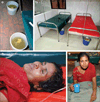Cholera
- PMID: 22748592
- PMCID: PMC3761070
- DOI: 10.1016/S0140-6736(12)60436-X
Cholera
Abstract
Cholera is an acute, secretory diarrhoea caused by infection with Vibrio cholerae of the O1 or O139 serogroup. It is endemic in more than 50 countries and also causes large epidemics. Since 1817, seven cholera pandemics have spread from Asia to much of the world. The seventh pandemic began in 1961 and affects 3-5 million people each year, killing 120,000. Although mild cholera can be indistinguishable from other diarrhoeal illnesses, the presentation of severe cholera is distinct, with pronounced diarrhoeal purging. Management of patients with cholera involves aggressive fluid replacement; effective therapy can decrease mortality from more than 50% to less than 0·2%. Antibiotic treatment decreases volume and duration of diarrhoea by 50% and is recommended for patients with moderate to severe dehydration. Prevention of cholera depends on access to safe water and sanitation. Two oral cholera vaccines are available and the most effective use of these in integrated prevention programmes is being actively assessed.
Copyright © 2012 Elsevier Ltd. All rights reserved.
Figures

References
-
- Morris JG., Jr. Cholera and other types of vibriosis: a story of human pandemics and oysters on the half shell. Clin Infect Dis. 2003 Jul 15;37(2):272–280. - PubMed
-
- Sack DA, Sack RB, Nair GB, Siddique AK. Cholera. Lancet. 2004 Jan 17;363(9404):223–233. - PubMed
-
- Cholera vaccines: WHO position paper. Weekly Epidemiological Record. 2010;85(13):117–128. - PubMed
Publication types
MeSH terms
Substances
Grants and funding
LinkOut - more resources
Full Text Sources
Medical

